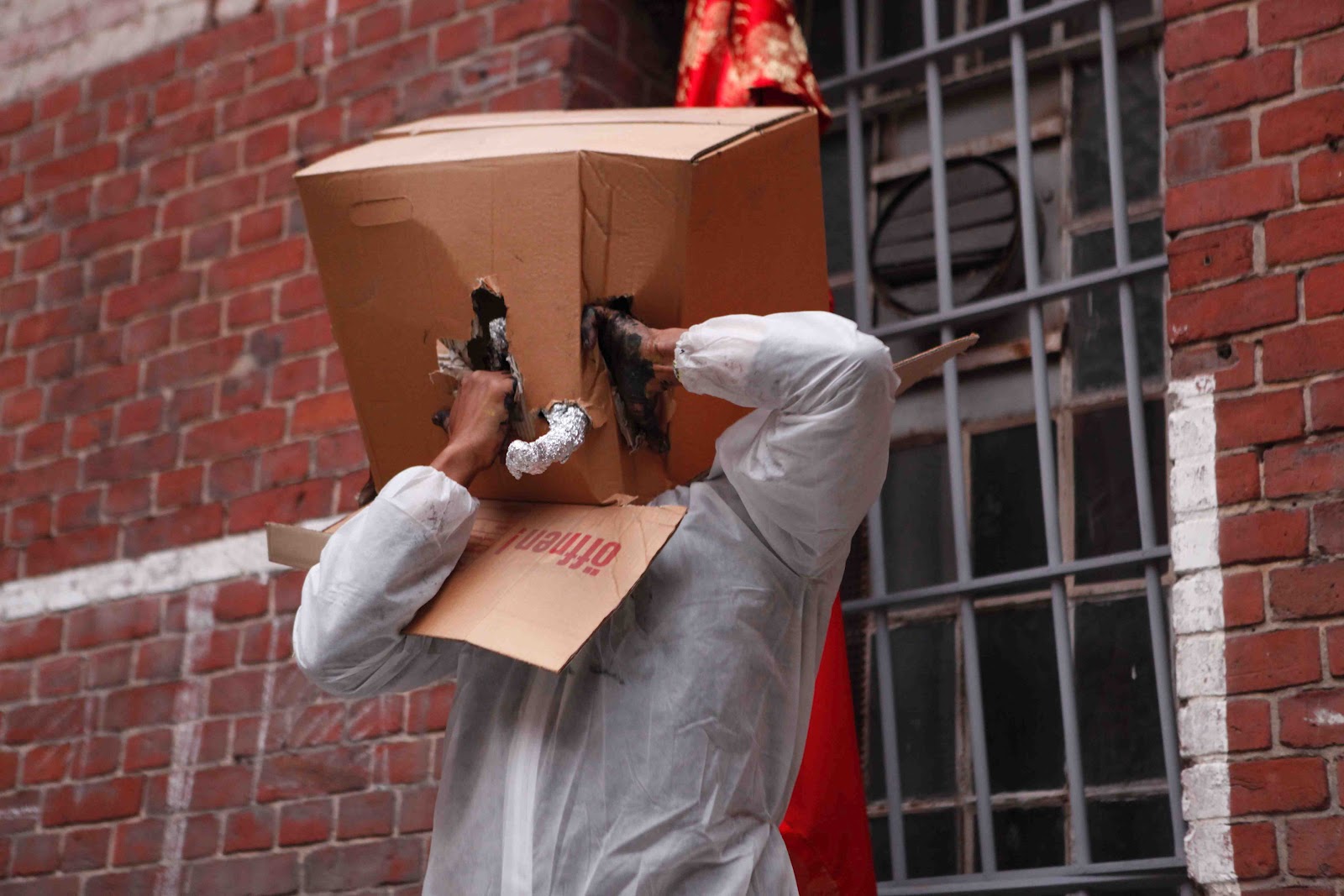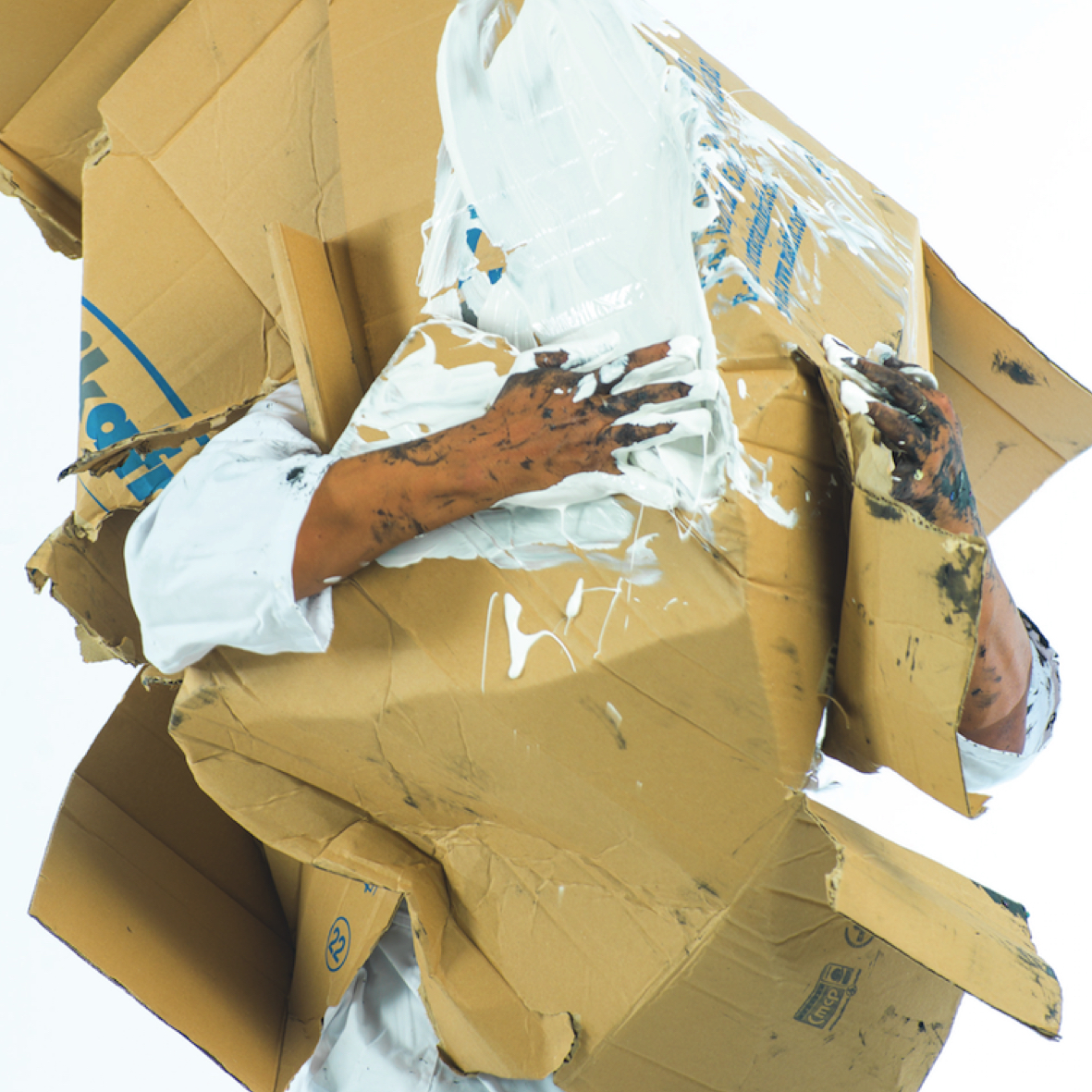Unravelling the oeuvre of multidisciplinary Moroccan artist Yassine Balbzioui
You want to, but you just can’t begin with the face; when obscured, rearranged, abstracted, or in the process of being covered, it surrenders its privilege of being the assumed starting point every viewer seeks in order to engage with a depicted figure – unless the substituted entity does, in fact, pull one in, that is. Masks, with their dark recesses referencing various facial cavities, or simply the presence of a ‘cover’ can intrigue one, leaving them with perplexing questions about the act of concealing.
The work of Moroccan visual artist Yassine Balbzioui leads viewers away from overt imagery, one-liners, and easy references. Known for his aversion to symbolism, Balbzioui’s oeuvre of performances, paintings, sculptures, and installations presents decontextualised figures in discreet spaces. His disconcerting images engage through disengagement with the traditional concept of portraiture, posing questions simply for the virtue of their existence. ‘When you impose an interpretation [on] the dream or the link with the work, the full experience is smothered’, Balbziou tells me. ‘To help someone love art for the first time, you should not give them clues about symbols,’ he remarks, explaining that ‘when you push symbolism to the foreground, you deprive the spectator [their] freedom of interpretation’.
Being conscious of a viewer’s first encounter with an artist’s work is of utmost important to contemporary Moroccan artists like Balbzioui. The art scene in Morocco is nascent and struggling to find its own voice, while being asked at the same time to justify the need for its presence. Larger cities like Casablanca, Rabat, Marrakech, and Tangier boast small and disjointed European art galleries, and with the exception of the Marrakech Museum for Photography and Visual Arts and a few others, museums are generally private institutions offering relatively little in terms of rotating exhibitions. ‘It was difficult for [us]’, says Balbzioui, a product of the School of Art in Casablanca, lamenting the lack of an artistic community available to him and his friends during the mid-90s. ‘There was no follow-through after school, no continuity. [The art scene] was dead … art school was like a suspended career’.

Grosse Tête (courtesy Mary Fang)
Like most artists hailing from Morocco, Balbzioui completed his art degree abroad. The three years he spent at the School of Fine Arts and Decorative Arts in Bordeaux, France, provided him with a component previously absent in his works: conscious thought. ‘In Morocco, I did things … I had a chance to study the basics in painting and drawing. In France, you think about things; now, I do both’. Although now living and working in France, Balbzioui will return to Morocco this month for the fifth edition of the Marrakech Biennale. This international arts exhibition, commenced in 2005 by Vanessa Branson, is acting as a much-needed catalyst for the development of the country’s art scene. Between February 26 and March 31, 43 international visual and sound artists will be participating in site-specific exhibitions curated by Moroccan artist Hicham Khalidi. In addition, numerous video, literary, and performance artists will be attending, all of whom will provide their interpretations of this year’s theme, which poses the question where are we now? For Balbzioui, the answer to this question, undoubtedly, is ‘without a face’. The artist is planning to perform his Grosse Tête (Big Head), a work derived from a theme developed during his residencies in Montluçon, Dakar, and Berlin. An ongoing performance, it will involve Balbzioui covering his head with various objects, substances, and materials. ‘These pieces have grown up with me’, he explains. ‘They are never the same. The relation between me and the pieces is where I am now’.
The cultural constructs of attractiveness and repulsion will be at the forefront of Balbzioui’s performance during the Biennale … The goal, he says, is to let people observe how a mutant form arises from a human one; gone will be the individual, as the artist’s identity is destroyed by his own hands
To date, Balbzioui has utilised boxes, cloth, and a variety of pre-made structures to cover his head. In one filmed performance of Grosse Tête in 2010, entitled Grosse Tête en Chute Libre (Big Head Freefall), Balbzioui wears what appeared to be a cardboard box wrapped in aluminium foil placed over his head. Wearing this ‘object’, he rolls down a hill for several seconds. The ensuing scenes are quick and inconclusive; like Balbzioui’s paintings, they are rather unremarkable, boasting florae not particular to any one region, a ‘cloudy’ atmosphere not placing the event in any particular time, and a glimpse of architecture in the background that could be found just about anywhere. As well, the artist’s actions also do not give any indication of a specific context; viewers do not know how Balbzioui came to find himself in that particular place, when he lay down, and if he did so under the box.
Grosse Tête, like the rest of Balbzioui’s works, capitalises on the transformative quality of ‘covering up’. In a 2012 essay, peer and fellow Moroccan artist Mohamed Rachdi penned a detailed investigation of this recurring theme in Balbzioui’s works. Entitled L’Obsession du Masque (The Obsession of the Mask), Rachdi concluded that this ‘element of concealing [the mask] is what does the revealing’. He continued to add that:
The mask is indicative of the paradoxical fragility that structures our way of life as it is based on our relationship to [one] another. It fertilises the links that weave us to each other between attractiveness and repulsion, seduction and hate …
The cultural constructs of attractiveness and repulsion will be at the forefront of Balbzioui’s performance during the Biennale. Unlike the simple structures seen in Grosse Tête en Chute Libre, Balbzioui intends to use liquids to conceal and reshape his head over a 20-minute period. The goal, he says, is to let people observe how a mutant form arises from a human one; gone will be the individual, as the artist’s identity is destroyed by his own hands. As Rachdi explained, by concealing his face, Balbzioui will reveal new possibilities:
Denying the traits that distinguish their individual identity, the mask opens the plural identity and makes the complexity of figures possible. Because they offer no face … the characters [wearing them] are transformed into spaces of infinite projections. Also, any spectator who contemplates [them] is brought to [project their] own face or multiple faces [on] a living memory. The works of Balbzioui become like so many reflective surfaces able to send each viewer to him or herself, their history, [the] entanglement of [their] concerns, and [their] imaginary and fantastical projections.
Balbzioui seems to see eye-to-eye with Rachdi. ‘I am not trying to produce a specific effect’, he explains. ‘I am physically involved [with] the work, and each person has their own experience depending on their [own] individual sensibilities and stories’.

